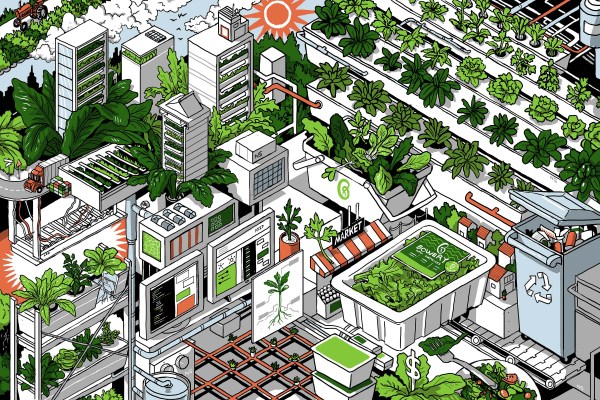Farming is the most fundamental activity of civilization. Efficient, reliable and abundant food allows the great majority of people today to eschew cultivating plants and raising livestock and instead pursue every other activity that makes up an economy. It’s also an enterprise that has seen extensive innovation over the millennia, and farming has never been more efficient than it is today.
Unfortunately, that’s no longer enough.
The skyrocketing global human population — expected to hit 10 billion sometime this century — coupled with the accelerating effects of the climate crisis are leading to a decisive crossroads: How can the world continually increase food production while also mitigating its overall environmental impact?
A growing chorus of researchers, activists and entrepreneurs believe that at least part of the solution is vertical, indoor farming. Once derided for tasteless vegetables and wild-eyed (read: unprofitable) schemes, vertical farms are increasingly compelling thanks to progressive technological improvements and more efficient designs.
While dozens of vertical farms have sprouted in the past decade, few have attracted the amount of attention that Manhattan-headquartered Bowery Farming enjoys. Founded in 2015, the company has raised nearly $500 million in venture capital — most recently at a $2.3 billion valuation — and is expanding from two experimental grow facilities and two production facilities to multiple scaled-up production hubs as it serves its leafy greens to customers at more than 850 grocery stores. The question the company asks is simple: Can it bring the newest and most innovative technologies to bear on civilization’s oldest and most optimized industry?
Answering that question in this TC-1 is Brian Heater, TechCrunch’s hardware editor. Heater has been writing about hardware and robotics for more than a decade and also hosts our annual TechCrunch Sessions: Robotics conference. As we’ll see shortly, hardware and robotics are key to making the Bowery model work at scale, profitably. The lead editor for this package was Danny Crichton, the assistant editor was Ram Iyer, the copy editor was Richard Dal Porto and illustrations were created by Nigel Sussman.
Bowery Farming had no say in the content of this analysis and did not get advance access to it. Heater has no financial ties to Bowery Farming.
The Bowery Farming TC-1 comprises four main articles measuring 11,100 words and 44 minutes of reading time. Here are the topics we’ll be uprooting:
- Part 1: Origin story “Bowery Farming is forcing us all to look up at the future of vertical agriculture” (3,500 words/14 minutes) — explores the evolution of vertical farming, it’s expansion in Japan and how Bowery Farming was started to bring indoor farming to the masses in the United States.
- Part 2: Produce development “Hacking lettuce for taste and profit” (2,500 words/10 minutes) — evaluates how Bowery collects data from its farms in order to optimize flavor while also potentially expanding its produce line into new categories like strawberries and turnips.
- Part 3: Agtech engineering “Can LEDs ultimately replace the sun?” (2,100 words/8 minutes) — investigates two of the most important questions about Bowery Farming: Can it develop a competitive moat with its technology (which it dubs BoweryOS) and just how much environmental benefit can the company derive from its farms?
- Part 4: Branding, finances and competitive landscape “The voracious fight for your salad bowl” (3,000 words/12 minutes) — looks at the extremely competitive nature of the produce section at the grocery store and how Bowery intends to build a brand with consumers while finding a route to profitability.
We’re always iterating on the TC-1 format. If you have questions, comments or ideas, please send an email to TechCrunch Managing Editor Danny Crichton at danny@techcrunch.com.
